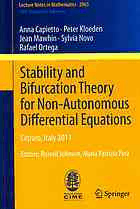
Stability and bifurcation theory for non-autonomous differential equations : Cetraro, Italy 2011 PDF
Preview Stability and bifurcation theory for non-autonomous differential equations : Cetraro, Italy 2011
Lecture Notes in Mathematics 2065 Editors: J.-M.Morel,Cachan B.Teissier,Paris Forfurthervolumes: http://www.springer.com/series/304 FondazioneC.I.M.E.,Firenze C.I.M.E. stands for Centro Internazionale Matematico Estivo, that is, International MathematicalSummerCentre.Conceivedintheearlyfifties,itwasbornin1954inFlorence, Italy,andwelcomedbytheworldmathematical community:itcontinues successfully,year foryear,tothisday. Many mathematicians from all over the world have been involved in a way oranother in C.I.M.E.’sactivitiesovertheyears.ThemainpurposeandmodeoffunctioningoftheCentre maybesummarisedasfollows:everyyear,duringthesummer,sessionsondifferentthemes from pure and applied mathematics are offered byapplication to mathematicians from all countries. ASessionis generally basedonthree orfourmaincourses given byspecialists ofinternationalrenown,plusacertainnumberofseminars,andisheldinanattractiverural locationinItaly. TheaimofaC.I.M.E.sessionistobringtotheattentionofyoungerresearcherstheorigins, development, and perspectives of some very active branch of mathematical research. The topicsofthecoursesaregenerallyofinternationalresonance.Thefullimmersionatmosphere ofthecoursesandthedailyexchangeamongparticipantsarethusaninitiationtointernational collaborationinmathematicalresearch. C.I.M.E.Director C.I.M.E.Secretary PietroZECCA ElviraMASCOLO DipartimentodiEnergetica“S.Stecco” DipartimentodiMatematica“U.Dini” Universita`diFirenze Universita`diFirenze ViaS.Marta,3 vialeG.B.Morgagni67/A 50139Florence 50134Florence Italy Italy e-mail:zecca@unifi.it e-mail:[email protected]fi.it FormoreinformationseeCIME’shomepage:http://www.cime.unifi.it CIMEactivityiscarriedoutwiththecollaborationandfinancialsupportof: -INdAM(IstitutoNazionalediAltaMatematica) -MIUR(Ministerodell’Universita’edellaRicerca) Anna Capietto Peter Kloeden Jean Mawhin (cid:2) (cid:2) Sylvia Novo Rafael Ortega (cid:2) Stability and Bifurcation Theory for Non-Autonomous Differential Equations Cetraro, Italy 2011 Editors: Russell Johnson Maria Patrizia Pera 123 AnnaCapietto SylviaNovo Universita`diTorino E.deIngenier´ıasIndustriales DipartimentodiMatematica DepartamentodeMatema´ticaAplicada Torino,Italy UniversidaddeValladolid Valladolid,Spain PeterKloeden Universita¨tFrankfurt RafaelOrtega Institutfu¨rMathematik UniversidaddeGranada Frankfurt,Germany DepartamentodeMatema´ticaAplicada Granada,Spain JeanMawhin Universite´CatholiquedeLouvain InstitutdeRecherche enMathe´matiqueetPhysique Louvain-la-Neuve,Belgium ISBN978-3-642-32905-0 ISBN978-3-642-32906-7(eBook) DOI10.1007/978-3-642-32906-7 SpringerHeidelbergNewYorkDordrechtLondon LectureNotesinMathematicsISSNprintedition:0075-8434 ISSNelectronicedition:1617-9692 LibraryofCongressControlNumber:2012951625 MathematicsSubjectClassification(2010):34B15,37B55,34C25,37E40,37G35,34K12 (cid:2)c Springer-VerlagBerlinHeidelberg2013 Thisworkissubjecttocopyright.AllrightsarereservedbythePublisher,whetherthewholeorpartof thematerialisconcerned,specificallytherightsoftranslation,reprinting,reuseofillustrations,recitation, broadcasting,reproductiononmicrofilmsorinanyotherphysicalway,andtransmissionorinformation storageandretrieval,electronicadaptation,computersoftware,orbysimilarordissimilarmethodology nowknownorhereafterdeveloped.Exemptedfromthislegalreservationarebriefexcerptsinconnection with reviews or scholarly analysis or material supplied specifically for the purpose of being entered and executed on a computer system, for exclusive use by the purchaser of the work. Duplication of this publication or parts thereof is permitted only under the provisions of the Copyright Law of the Publisher’slocation,initscurrentversion,andpermissionforusemustalwaysbeobtainedfromSpringer. PermissionsforusemaybeobtainedthroughRightsLinkattheCopyrightClearanceCenter.Violations areliabletoprosecutionundertherespectiveCopyrightLaw. Theuseofgeneraldescriptivenames,registerednames,trademarks,servicemarks,etc.inthispublication doesnotimply,evenintheabsenceofaspecificstatement,thatsuchnamesareexemptfromtherelevant protectivelawsandregulationsandthereforefreeforgeneraluse. While the advice and information in this book are believed to be true and accurate at the date of publication,neithertheauthorsnortheeditorsnorthepublishercanacceptanylegalresponsibilityfor anyerrorsoromissionsthatmaybemade.Thepublishermakesnowarranty,expressorimplied,with respecttothematerialcontainedherein. Printedonacid-freepaper SpringerispartofSpringerScience+BusinessMedia(www.springer.com) Preface TheCIMEsession“StabilityandBifurcationTheoryforNon-AutonomousDiffer- entialEquations”washeldatCetraroItaly,from19to25June2011.Thisvolume containsthenotesofthefivelecturecourseswhichwereheldonthatoccasion. One of ourgoalsin organizingthe session was to fostera comparisonbetween the“topological”and“dynamical”approachestothestudyofnonautonomousdif- ferentialequations.Anothergoalwastofacilitatetheinteractionbetweenspecialists versed in the one approachor the other. We are amply convincedthat those goals werefulfilled. In these course notes, the reader will find a systematic introduction to many of the themes and methodswhich make up the modern theory of nonautonomous differential and dynamical systems. Topics pertaining to differential equations in finite and infinite dimensions receive sustained attention. Also, discrete equations and systems have an important place in the notes. This is natural both because a differentialequation is often studied via an appropriatediscretization process and because nonautonomous discrete systems are of fundamental importance in their ownright. Here is a partial list of the various themes which were taken up in the course ofthelectures:boundedorbitsandstabilityinnon-periodicmonotonetwistmaps; properties of the minimal subsets of nonautonomousmonotone differential-delay systems;resonancephenomenain nonautonomousordinarydifferentialequations; existenceandpropertiesofpullbackattractorsinskew-productdynamicalsystems; andtheuseoftheMaslovindexinbifurcationproblemsregardingnonautonomous Hamiltoniansystems.Ofcourseanimpressiverangeofothertopicswasconsidered aswell,andanamplequantityofspecificproblemswasdiscussed. Themethodsintroducedbythespeakersinthetheoreticaldevelopmentsandin the treatment of specific problems may be divided into two classes. First, the use of “classical” techniques drawn from the topological degree theory, the calculus of variations, the search for upper/lower solutions, and others of a similar vein. Second, the use of “dynamical” constructs such as processes and skew-product flows, minimal sets and omega-limit sets, pullback attractors, invariant measures, andthelike. v vi Preface Hereisabriefdescriptionofeachofthecourseswhichmadeupthesession. – Anna Capietto (Torino) considered a broad class of boundary value problems posedfornonautonomousnonlinearHamiltoniansystems.Shestatedandproved bifurcationresultsof“Rabinowitz”typefortheseproblems.Sheshowedhowthe Maslovindexcanbeusedasaneffectivetoolinderivingsuchresults. – PeterKloeden(Frankfurt)gaveanintroductiontothelanguageandconceptsof nonautonomousdiscretedynamicalsystems.Hediscussedthetheoryofpullback attractorsandwentontomentionsomeresultsfromnonautonomousbifurcation theory.Healsotookupsomequestionsintheareaofrandomdynamicalsystems. – Jean Mawhin (Louvain-la-Neuve) discussed a number of illustrative nonlinear nonautonomous resonance problems. He effectively used a mix of methods drawn from the Leray–Schauder theory, the calculus of variations, and the technique of upper and lower solutions. He presented many results regarding existenceandmultiplicityofperiodicsolutionsofcertainparadigmaticperiodi- callyforcedODEs. – Sylvia Novo (Valladolid) considered a significant class of nonautonomous functionaldifferentialequationshavingmonotonicityproperties.Shestudiedthe existenceandthestabilitypropertiesofminimalsets,togetherwiththeexistence andstructuralpropertiesofglobalattractors.Shegaveseveralapplications,e.g., tothetheoryofneuralnetworksandtothatofcompartmentalsystems. – Rafael Ortega (Granada) first discussed the existence of bounded orbits and invariantcurvesforexactsymplectictwistmapsonthecylinderandespeciallyon theplane.Theresultsoninvariantcurveshavestabilitystatementsascorollaries. HemadeuseofavariationalprincipleofMathertype.Hethenanalyzedcertain impactproblems,especiallytheso-calledping-pongmodel. Thesessionwasattendedbyabout50scientistsof“topological”and“dynamical” extractions. Their good-natured and active participation in the courses and their individual discussions helped to create a positive atmosphere which certainly facilitatedtheexchangeofscientificideas.Webelievethattheinteractionbetween specialists in the topological and in the dynamical approachesto nonautonomous differentialequationswasgreatlyenrichedbythisCIMEsession. Firenze,Italy RussellJohnson 19Dec2011 MariaPatriziaPera Contents The Maslov Index and GlobalBifurcationfor Nonlinear BoundaryValueProblems ...................................................... 1 AlbertoBoscaggin,AnnaCapietto,andWalterDambrosio 1 IntroductionandClassicalResults ........................................... 1 2 TheMaslovIndex............................................................. 7 3 TheNumberofMomentsofVerticality...................................... 12 4 ThePhase-AnglesandtheNumberofMomentsofVerticality ............. 16 5 SomeRelatedNotions ........................................................ 21 6 NonlinearFirstOrderSystemsinR2N ....................................... 24 7 NonlinearDirac-TypeSystemsintheHalf-Line............................. 27 References......................................................................... 32 Discrete-TimeNonautonomousDynamicalSystems......................... 35 P.E.Kloeden,C.Po¨tzsche,andM.Rasmussen 1 Introduction.................................................................... 36 2 AutonomousDifferenceEquations........................................... 37 2.1 AutonomousSemidynamicalSystems................................. 39 2.2 LyapunovFunctionsforAutonomousAttractors...................... 40 3 NonautonomousDifferenceEquations....................................... 43 3.1 Processes ................................................................ 44 3.2 Skew-ProductSystems.................................................. 45 4 AttractorsofProcesses........................................................ 50 4.1 NonautonomousInvariantSets......................................... 51 4.2 ForwardsandPullbackConvergence................................... 52 4.3 ForwardsandPullbackAttractors...................................... 53 4.4 ExistenceofPullbackAttractors....................................... 54 4.5 LimitationsofPullbackAttractors..................................... 59 5 AttractorsofSkew-ProductSystems......................................... 61 5.1 ExistenceofPullbackAttractors....................................... 61 5.2 ComparisonofNonautonomousAttractors............................ 64 vii viii Contents 5.3 LimitationsofPullbackAttractorsRevisited.......................... 66 5.4 LocalPullbackAttractors............................................... 68 6 LyapunovFunctions........................................................... 69 6.1 ExistenceofaPullbackAbsorbingNeighbourhoodSystem.......... 70 6.2 NecessaryandSufficientConditions................................... 72 7 Bifurcations.................................................................... 79 7.1 HyperbolicityandSimpleExamples................................... 80 7.2 AttractorBifurcation.................................................... 86 7.3 SolutionBifurcation .................................................... 88 8 RandomDynamicalSystems................................................. 92 8.1 RandomDifferenceEquations ......................................... 93 8.2 RandomAttractors...................................................... 94 8.3 RandomMarkovChains................................................ 96 8.4 ApproximatingInvariantMeasures .................................... 98 References......................................................................... 100 ResonanceProblemsforSomeNon-autonomousOrdinary DifferentialEquations........................................................... 103 JeanMawhin 1 Introduction,NotationsandPreliminaryResults ............................ 103 1.1 Introduction ............................................................. 103 1.2 Notations ................................................................ 105 1.3 ClassesofHomeomorphisms........................................... 107 1.4 ANonlinearProjector................................................... 109 2 TopologicalApproach......................................................... 112 2.1 Introduction ............................................................. 112 2.2 DirichletProblem....................................................... 112 2.3 PeriodicProblem........................................................ 114 2.4 NeumannProblemforSingular(cid:2)...................................... 145 3 LagrangianVariationalApproach ............................................ 147 3.1 Introduction ............................................................. 147 3.2 TheFunctionalFramework............................................. 147 3.3 GroundStateSolutions ................................................. 153 3.4 SaddlePointSolutionsforBoundedNonlinearities................... 159 3.5 MultipleSolutionsNearResonance.................................... 162 3.6 BV Periodic Solutions of the Forced Pendulum withCurvatureOperator................................................ 169 4 HamiltonianVariationalApproach........................................... 172 4.1 Introduction ............................................................. 172 4.2 AnEquivalentHamiltonianSystemandItsAction ................... 174 4.3 MultiplicityofPeriodicSolutions...................................... 177 References......................................................................... 179 Contents ix Non-autonomousFunctionalDifferentialEquations andApplications ................................................................. 185 SylviaNovoandRafaelObaya 1 Introduction.................................................................... 185 2 BasicNotionsandResults .................................................... 189 2.1 FlowsOverCompactMetricSpaces................................... 189 2.2 AlmostPeriodicandAlmostAutomorphicDynamics................ 192 2.3 SomeImportantODEsExamples...................................... 195 2.4 OrderedBanachSpaces:MonotoneSkew-ProductSemiflows ....... 203 3 Non-autonomousFDEswithFiniteDelay................................... 206 3.1 CooperativeandIrreducibleSystemsofFiniteDelayEquations..... 210 3.2 SemicontinuousEquilibriaandAlmostAutomorphicExtensions.... 216 3.3 MonotoneandConcaveorSublinearCases ........................... 220 3.4 ANon-autonomousCyclicFeedbackSystem......................... 225 3.5 CellularNeuralNetworks............................................... 229 4 Non-autonomousCyclicFDEswithInfiniteDelay.......................... 237 4.1 StabilityandExtensibilityResultsforOmega-LimitSets ............ 237 4.2 FDEswithInfiniteDelay ............................................... 240 4.3 MonotoneFDEswithInfiniteDelay................................... 249 4.4 CompartmentalSystems................................................ 255 References......................................................................... 259 TwistMappingswithNon-PeriodicAngles.................................... 265 MarkusKunzeandRafaelOrtega 1 Introduction.................................................................... 265 2 SymplecticMapsinthePlaneandintheCylinder .......................... 270 3 TheTwistConditionandtheGeneratingFunction.......................... 274 4 TheVariationalPrinciple...................................................... 277 4.1 TheFrenkel–KontorowaModel........................................ 277 4.2 AGeneralFramework .................................................. 278 5 ExistenceofCompleteOrbits................................................. 281 6 TheActionFunctionalofaNewtonianEquation............................ 286 7 ImpactProblemsandGeneratingFunctions................................. 290 7.1 TheDirichletProblem.................................................. 291 7.2 TheConditionofElasticBouncing .................................... 293 7.3 ABouncingBall ........................................................ 294 8 CommentsandBibliographicalRemarks.................................... 296 References......................................................................... 299 ListofParticipants............................................................... 301
